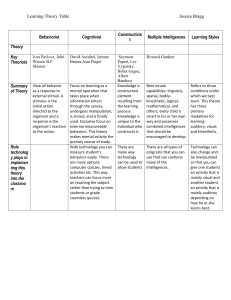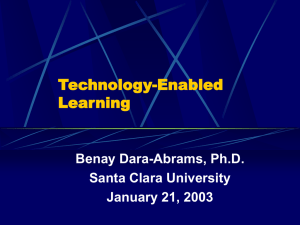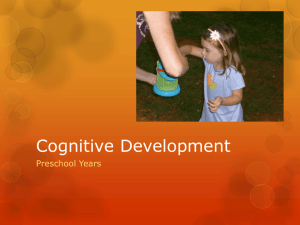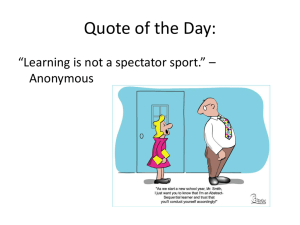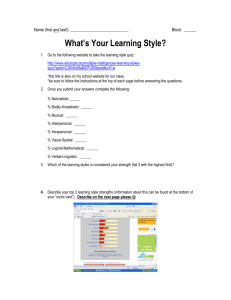Bringing Literature to Life A Research Based, Integrated Model for
advertisement
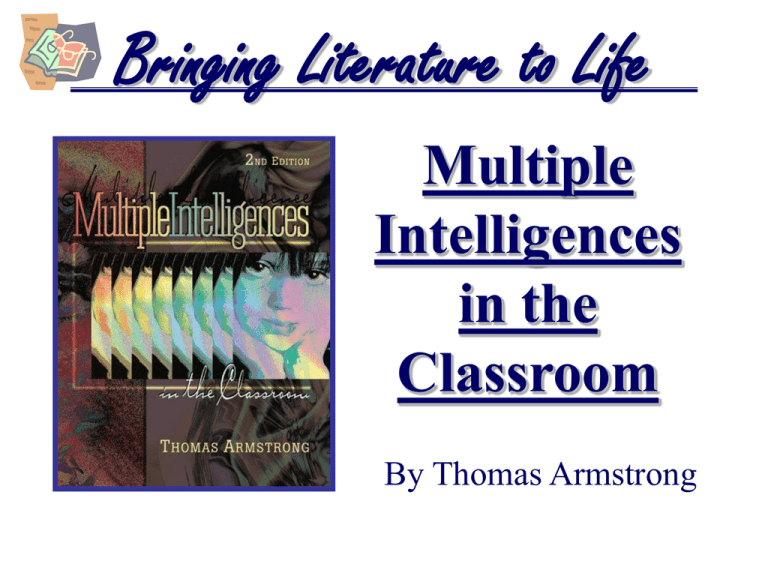
Bringing Literature to Life Multiple Intelligences in the Classroom By Thomas Armstrong Eight Ways of Learning Children who are highly: THINK LOVE NEED in words reading, writing, telling stories, playing word games books, tapes, writing tools, paper, diaries, dialogue, discussion, debate, stories by reasoning experimenting, questioning, figuring out logical puzzles, calculating materials to experiment with, science materials, manipulatives, trips to the planetarium and science museums SpatialMechanical in images and pictures designing, drawing, visualizing, doodling art, LEGOS, video, movies, slides, imagination games, mazes, puzzles, illustrated books, trips to art museums BodilyKinesthetic through somatic sensations dancing, running, jumping, building, touching, gesturing role play, drama, movement, things to build, sports and physical games, tactile experiences, hands-on learning Musical via rhythms and melodies singing, whistling, humming, tapping feet and hands, listening sing-along time, rips to concerts, music playing at home and school, musical instruments Interpersonal by bouncing ideas off other people leading, organizing, relating, manipulating, mediating, partying friends, groups games, social gatherings, community events, clubs, mentors/apprenticeships Intrapersonal in relation to their needs, feelings and goals setting goals, meditating, dreaming, planning, reflecting secret places, time alone, self-paced projects, choices Naturalist through nature and natural forms playing with pets, gardening, investigating nature, raising animals, caring for planet earth access to nature, opportunities for interacting with animals, tools for investigating nature (e.g., magnifying glass, binoculars) VerbalLinguistic LogicalMathematical Eight Ways of Teaching Intelligence Teaching Activities Teaching Materials Instructional Strategies lectures, discussions, word games, storytelling, choral reading, journal writing books, tape recorders, word processors, stamp sets, books on tapes read about it, write about it, talk about it, listen to it brain teasers, problem solving, science experiments, number games, mental calculation,, critical thinking calculators, math manipulatives, science equipment, math games quantify it, think critically about it, put it in a logical framework, experiment with it SpatialMechanical visual presentations, art activities, imagination games, mind-mapping, metaphor, visualization graphs, maps, videos, LEGO sets, art materials, optical illusions, camera, picture library see it, draw it, visualize it, color it mind-map-it BodilyKinesthetic hands-on learning, drama, dance, sports that teach, tactile activities, relaxation exercises building tools, clay, sports equipment, manipulatives, tactile learning resources build it, act it out, touch it, get a “gut feeling” of it, dance it Musical rhythmic learnings, rapping, using songs that teach tape recorders, tape collection, musical instruments sing it, rap it, listen to it Interpersonal cooperative learning, peer tutoring, simulations, community involvement, social gathering board games, party supplies, props for role plays teach it, collaborate on it, interact with respect to it Intrapersonal individualized instruction, independent study, options in course of sturdy, self-esteem building self-checking materials, journals, materials for projects connect it to your personal life, make choices with regard to it, reflect on it nature study, ecological awareness, care of animals plants, animals, naturalists’ tools, (e.g. binoculars), gardening tools connect it to living things and natural phenomena VerbalLinguistic LogicalMathematical Naturalist Blooms Taxonomy Competence Knowledge Comprehension Application Analysis Synthesis Evaluation Skills Demonstrated * observation and recall of information *knowledge of dates, events, places *knowledge of major ideas *mastery of subject matter Question Cues: list, define, tell, describe, identify, show, label, collect, examine, tabulate, quote, name, who, when, where, etc. *understanding information *grasp meaning *translate knowledge into new context *interpret facts, compare, contrast *order, group, infer causes *predict consequences Question Cues: summarize, describe, interpret, contrast, predict, associate, distinguish, estimate, differentiate, discuss, extend *use information *use methods, concepts, theories in new situations *solve problems using required skills or knowledge Questions Cues: apply, demonstrate, calculate, complete, illustrate, show, solve, examine, modify, relate, change, classify, experiment, discover *seeing patterns *organization of parts *recognition of hidden meanings *identification of components Question Cues: analyze, separate, order, explain, connect, classify, arrange, divide, compare, select, explain, infer *use old ideas to create new ones *generalize from given facts *relate knowledge from several areas *predict, draw conclusions Question Cues: combine, integrate, modify, rearrange, substitute, plan, create, design, invent, what if?, compose, formulate, prepare, generalize, rewrite *compare and discriminate between ideas *assess value of theories, presentations *make choices based on reasoned argument *verify value of evidence *recognize subjectivity Question Cues: assess, decide, rank, grade, test, measure, recommend, convince, select, judge, explain, discriminate, support, conclude, compare, summarize Blooms Taxonomy & Multiple Intelligences (Ecology Unit: Local environment-trees in your neighborhood) Intelligences Knowledge Comprehension Application Analysis Synthesis Evaluation VerbalLinguistic memorize names of trees explain how trees receive nutrients give description of tree diseases, suggest cause of each disease describe how each part of a tree functions in relation to the whole write a paper describing the life cycle of a tree rate different methods of controlling tree growth LogicalMathematical remember number of points on specific leaves convert English to metric in calculating height of tree given height of smaller tree, estimate height of larger tree analyze materials found in sap residue given weather, soil etc. chart projected growth of a tree rate different kinds of tree nutrients based on data SpatialMechanical remember basic configurations of specific trees look at diagrams of trees and tell what stages of growth they are in use geometric principles to determine height of tree draw cellular structure of tree root create a landscape plan using trees as a central feature evaluate practicality of different landscape plans BodilyKinesthetic identify tree by the feel of the bark given array of tree fruits, identify seeds given type of local tree, find an ideal place for planting create different parts of tree from clay gather all materials needed to plant a tree evaluate the quality of different kinds of fruit Musical remember songs that deal with trees explain how old tree songs came into being change the lyrics of an old song to reflect current issues classify songs by issue and historical period create your own tree song based on information in this unit rate songs from the best to worst and give reasons for your choices Interpersonal record responses to the question, “What is your favorite tree?” determine the most popular tree in class by interviewing others use survey results to pick location for field trip to orchard classify kids into groups according to favorite tree arrange a field trip to orchard by contacting necessary people rank three methods to ask others about tree preference Intrapersonal remember a time you climbed a tee share the primary feeling you had while up in the tree develop “tree climbing rules” based on your own experience divide up your experience into “beginning,” “middle’” and “end” plan a tree climbing expedition based on you past experience explain what you liked “best and “least” about your experience learn to discriminate different tree leaves by sight explain how other living beings benefit from trees create a system for classifying different tree leaves analyze the function of a given tree in terms of the larger ecosystem plan an approach for protecting specific trees in your neighborhood evaluate which trees in your neighborhood are most eco-valuable Naturalist Blooms Taxonomy & Multiple Intelligences (Unit;_________________________________________________________________) Intelligences VerbalLinguistic LogicalMathematical SpatialMechanical BodilyKinesthetic Musical Interpersonal Intrapersonal Naturalist Knowledge Comprehension Application Analysis Synthesis Evaluation Multiple Intelligence: Planning Questions Verbal Linguistic How can I use the spoken or written word? Naturalist How can I incorporate living things, natural phenomena, or ecological awareness? Intrapersonal How can I evoke personal feelings or memories, or give students choices? Logical-Mathematical How can I bring in numbers, calculations, logic, classifications, or critical thinking skills? Objective Interpersonal How can I engage students in peer sharing, cooperative learning, or large group simulation? Spatial Mechanical How can I use visual aids, visualization, color, art, or metaphor? Musical How can I bring in music or environmental sounds, or set key points in a rhythmic or melodic framework? Bodily-Kinesthetic How can I involve the whole body or use handson experiences? Multiple Intelligence: Planning Questions Verbal Linguistic Logical-Mathematical Spatial Mechanical Musical Naturalist __________ Intrapersonal Bodily-Kinesthetic Interpersonal

